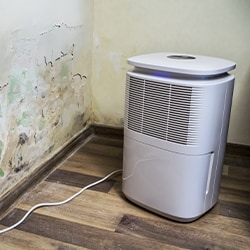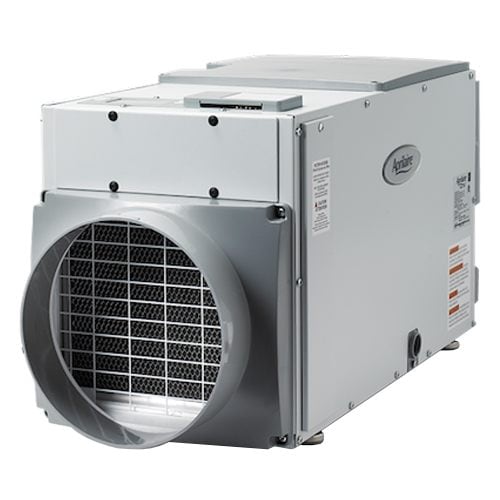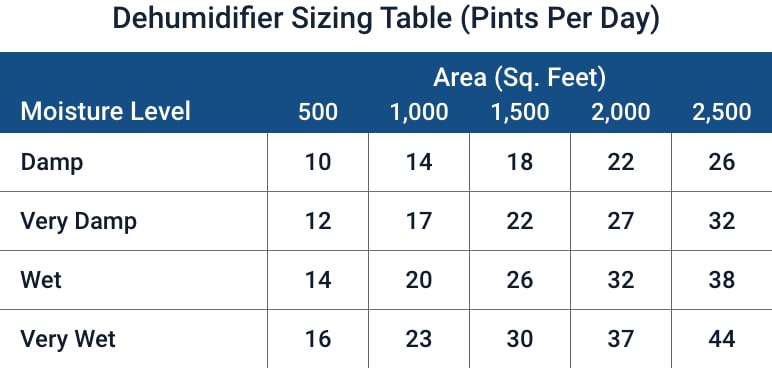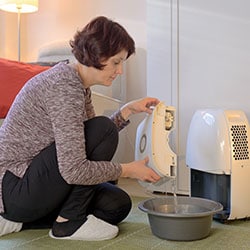
What Does a Dehumidifier Do?
You're probably familiar with that damp, muggy feeling in your home. Your skin feels clammy, and it seems hard to get a breath of fresh air. The culprit is a high concentration of water vapor in the air, or humidity.
High humidity can make it feel extra hot and sticky during the summer and foster the perfect environment for mold, mildew, and other allergens to multiply in your home and possibly cause health problems.
The cure for high humidity is a home dehumidifier.
What is a Dehumidifier?
A dehumidifier uses condensation to remove excess water from the air, keeping humidity at the recommended comfortable levels of 40% to 60%. It is the opposite of a humidifier, which adds water vapor to the air. Using a dehumidifier can maximize home comfort, especially during spring and summer.
How Does a Dehumidifier Work?
 A dehumidifier works by drawing in humid air over a cold coil which uses condensation to collect the water from the air. Think of the cold coil as a cold glass of water on a hot, humid day. Just like water from the air condenses and forms droplets on the cold glass, so too does water collect on the dehumidifier coil.
A dehumidifier works by drawing in humid air over a cold coil which uses condensation to collect the water from the air. Think of the cold coil as a cold glass of water on a hot, humid day. Just like water from the air condenses and forms droplets on the cold glass, so too does water collect on the dehumidifier coil.
The coil stays cold thanks to refrigerant flowing through it. In this sense, a dehumidifier works like an air conditioner but in reverse because it both dries and cools the incoming air. The difference is that a dehumidifier partially reheats the dried air before sending it back into the home. Otherwise, you'd be cooling down your house every time you used the dehumidifier.
To summarize, a dehumidifier works as follows:
- The dehumidifier draws in moist air with a fan.
- Moist air passes over a cooling coil, which collects the water through condensation.
- Collected water drains into a bucket or floor drain.
- Dried air is warmed before reentering the home.
After reading this, you might be wondering why you can't just use your air conditioner as a dehumidifier since they basically work the same way. You certainly can-to an extent. An air conditioner is designed to cool your home, so once the setpoint temperature is met, it will shut down whether it's humid or not.
A dehumidifier will keep running until it reaches the desired humidity levels, which you can set using a humidistat. Although not designed to cool your home, a dehumidifier can make it feel cooler and reduce how often you use your air conditioner, which can save energy.
Types of Dehumidifiers
Two types of dehumidifiers are available on the market: portable and whole-house dehumidifiers.
Portable Dehumidifiers are designed to remove moisture from a single room or space. You can put one in the room you spend the most time in, or in a room with mold. Another practical use is in flooded rooms. After you've drained the water out, use a large portable dehumidifier to eliminate all the airborne moisture.

Whole-House Dehumidifiers, also known as HVAC dehumidifiers, are installed in your central heating and cooling system and use ductwork to dehumidify your entire home. They can also be installed with their own dedicated duct. Although they are more expensive than portable units and require professional installation, whole-house dehumidifiers are the solution for protecting wood floors, furniture, and every room from moisture.
Sizing a Dehumidifier
Sizing a dehumidifier depends primarily on the size of the room or home and the level of moisture in it. Dehumidifiers are rated by the number of pints of water they can remove in one day, or pints/day.
Follow these steps to size a dehumidifier:
- First, measure the square footage of the space you want to dehumidify, whether it's your entire home or one room.
- Next, use the following scale to determine the level of moisture in your home.
Damp: Room occasionally feels clammy and/or has a mild musty smell.
Very Damp: Room always feels clammy and has a strong musty smell.
Wet: Occasional condensation and mold on walls and ceiling.
Very Wet: Constant condensation and mold on walls and ceilings. Standing water.
- Now, match your moisture level with the square footage of the space you want to dehumidify in the table below.

For example, if you have a very damp room that is 500 square feet, you'll need a dehumidifier rated to remove at least 12 pints of water per day. To remove moisture faster, you can buy a higher-rated unit, but it will probably use more electricity.
It's very important to understand that a dehumidifier's rating only represents the unit's performance at a certain temperature or range of temperatures. The colder it gets, the less effective a dehumidifier gets because it's harder to condense colder air over the refrigerant coils. For example, you might see a dehumidifier rated to remove 70 pints/day at 80° F. It will remove less at colder temperatures.
Most dehumidifiers will start becoming ineffective at around 50° F and stop working completely below 40° F.
How to Use a Dehumidifier
 Using a dehumidifier differs substantially depending on whether you have a portable or whole-house unit.
Using a dehumidifier differs substantially depending on whether you have a portable or whole-house unit.
A portable dehumidifier is manually operated. Plug it into the room you want to dehumidify, turn it on, and choose your desired humidity level. Most importantly, remember to empty out the water tray when it gets full. Dehumidifiers will temporarily stop working when they've collected their max capacity of water to avoid flooding.
Since whole-house dehumidifiers are installed in your HVAC system or through a dedicated vent line, they are largely automated. Set the desired humidity on the humidistat just like you would the temperature on the thermostat and the dehumidifier will turn on when necessary. All water is drained to your plumbing system so no need to empty trays. The only regular maintenance is to replace the dehumidifier air filter every 60-90 days as you would a furnace filter.
Say Bye to Excess Moisture
A dehumidifier will help you feel more comfortable at home, reduce mold and damage to wood products, and even take some of the load off your air conditioner in the summer. Bot portable and HVAC dehumidifiers will leave your home better off.
Just be careful not to dehumidify your home too much to avoid the opposite problem-excessive dryness.
If you have more questions about buying a dehumidifier for you home, give us a call at (866) 631-6389 to speak with an expert.





